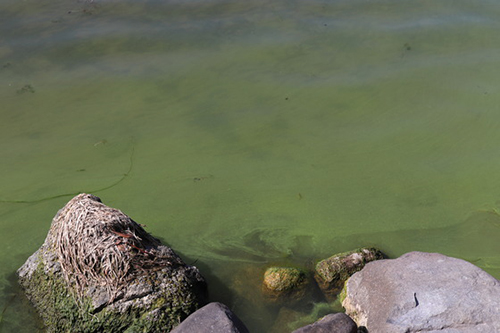When it comes to blue-green algae, stay out of water


Beachgoers are reminded to watch for blue-green algae this summer. Blue-green algae can have harmful effects on humans and pets, including illness, if swallowed or inhaled in water droplets, or irritation, if rubbed on the skin.
Blue-green algae or cyanobacteria, are photosynthetic bacteria and can appear in two distinct ways. Planktonic blue-green algae look like tiny particles, dust or grass clippings floating in the water, and are most often green, tan, reddish-purple or blue. Bottom-dwelling mats of benthic blue-green algae can float to the surface and are often brown, black or turquoise in color.
When environmental conditions are just right, bluegreen algae can increase in number to visible accumulations called “blooms.” Planktonic blue-green algae blooms float to the surface and form scums, paint-like conditions or “pea soup” water, containing billions of tiny particles.
In Wisconsin, blue-green algae blooms generally occur from mid-June to late September, with peak bloom season in July and August, when waters are at their warmest.
Blue-green algae grow in all waterbodies in Wisconsin. Waters with high nutrient levels, like nitrogen and phosphorus, are most susceptible to blooms, but even lakes with excellent water quality may occasionally experience small blooms, especially after periods of calm weather.
Bottom-dwelling benthic mats are often seen in lakes with clear water, since sunlight needs to reach the bottom.
Most lakes and rivers in Wisconsin, are not tested for blue-green algae, so it is important to know what it looks like and always assess conditions before swimming.
Do not swim in water that looks like “pea soup,” spilled paint or water that has a scum layer, mats or puffy blobs floating on the surface. All of these may be blue-green algae and the abundant particles can also host high bacteria levels. Do not boat, water ski, etc., over such water, to reduce inhalation exposure.
Do not let children play with scum layers, even from shore. Always shower after contact with any surface water, whether or not a blue-green algae bloom appears to be present, since surface waters may contain other species of potentially harmful bacteria, viruses or parasites.
Always avoid swallowing untreated surface water, because it may contain bacteria, viruses and parasites that could make one sick. When in doubt, stay out.
Symptoms of blue-green algal toxin poisoning in people include vomiting and diarrhea from ingestion, and sore throat and wheezing, from inhalation. Some people also experience skin irritation and rashes, in areas where the algae are held against their skin under clothing.
Blue-green algae can have harmful effects, if ingested by pets. Dogs are not deterred by surface scum and can swallow water while swimming. They may eat floating material in the water or mats washed up on shore, or lick blue-green algae from their coats, after swimming.
If the blue-green algae they ingest produces toxins, the animals can become ill and even die. Symptoms of bluegreen algal toxin poisoning in pets may range from lethargy and weakness, to vomiting, difficulty breathing and seizures, requiring immediate veterinary care.
When looking for a safe place for pets to swim, choose the clearest water possible, and keep pets out of areas with accumulations of blue-green algae or dense particulate matter. If there’s any doubt about what is in the water, keeping pets out is the safest course of action.
Do not let pets or livestock swim in, or drink, waters experiencing blue-green algae blooms. Always offer fresh, clean water for pets to drink, instead of lake water.
Wash pets off with clean water, immediately after swimming, so they don’t lick any algae from their fur. Supervise pets when outside; if a pet eats grass, avoid using lake water for lawn irrigation, if blooms are present.
Give dogs plenty of breaks from swimming and retrieving in lakes, avoid having dogs bite at splashed water as a game and use flat objects for retrieval, instead of balls.
The public is encouraged to report significant bluegreen algae blooms to the DNR, at DNRHABS@wisconsin. gov. Include the location of the bloom, name of the waterbody, nearest town, county, size and duration of the bloom, and overall and close-up photographs for verification. The DNR is unable to test all reported blooms.





